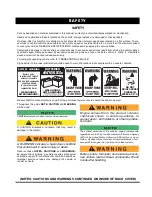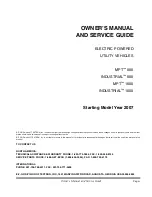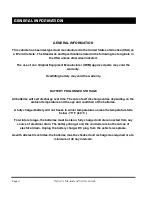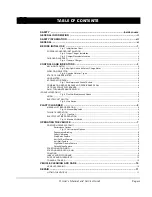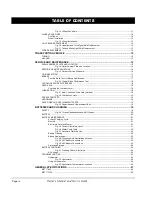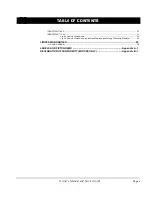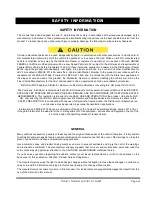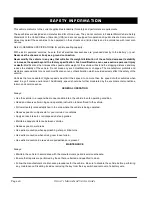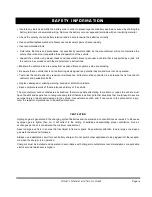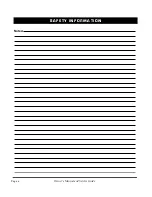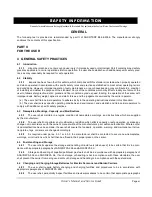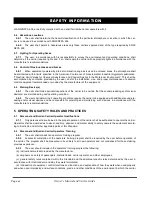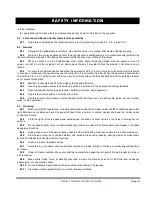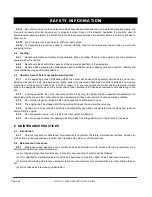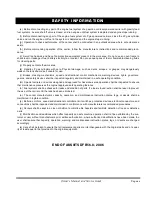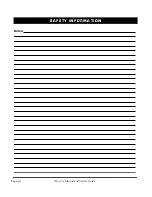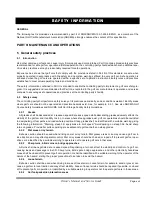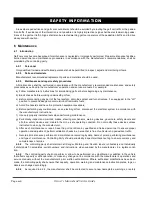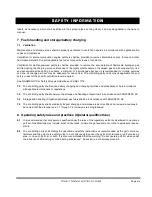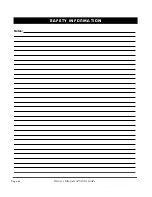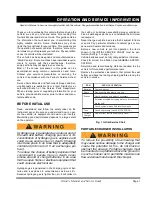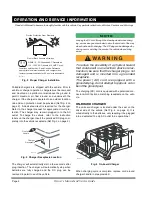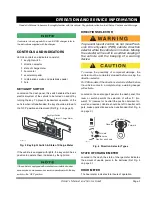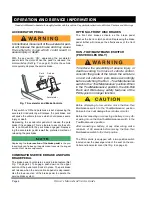
Owner’s Manual and Service Guide
Page ix
SAFETY INFORMATION
• Insulate any tools used within the battery area in order to prevent sparks or battery explosion caused by shorting the
battery terminals or associated wiring. Remove the battery or cover exposed terminals with an insulating material.
• Check the polarity of each battery terminal and be sure to rewire the batteries correctly.
• Use specified replacement parts. Never use replacement parts of lesser quality.
• Use recommended tools.
• Determine that tools and procedures not specifically recommended by the manufacturer will not compromise the
safety of personnel nor jeopardize the safe operation of the vehicle.
• Support the vehicle using wheel chocks and jack stands. Never get under a vehicle that is supported by a jack. Lift
the vehicle in accordance with the manufacturer’s instructions.
• Maintain the vehicle in an area away from exposed flame or persons who are smoking.
• Be aware that a vehicle that is not performing as designed is a potential hazard and must not be operated.
• Test drive the vehicle after any repairs or maintenance. All tests must be conducted in a safe area that is free of both
vehicular and pedestrian traffic.
• Replace damaged or missing warning, caution or information labels.
• Keep complete records of the maintenance history of the vehicle.
The manufacturer cannot anticipate all situations, therefore people attempting to maintain or repair the vehicle must
have the skill and experience to recognize and protect themselves from potential situations that could result in severe
personal injury or death and damage to the vehicle. Use extreme caution and, if unsure as to the potential for injury,
refer the repair or maintenance to a qualified mechanic.
VENTILATION
Hydrogen gas is generated in the charging cycle of batteries and is explosive in concentrations as low as 4%. Because
hydrogen gas is lighter than air, it will collect in the ceiling of buildings necessitating proper ventilation. Five air
exchanges per hour is considered the minimum requirement.
Never charge a vehicle in an area that is subject to flame or spark. Pay particular attention to natural gas or propane
gas water heaters and furnaces.
Always use a dedicated circuit for each battery charger. Do not permit other appliances to be plugged into the recepta-
cle when the charger is in operation.
Chargers must be installed and operated in accordance with charger manufacturers recommendations or applicable
electrical code (whichever is higher).
Summary of Contents for INDUSTRIAL 1000 2007
Page 8: ...Page vi Owner s Manual and Service Guide TABLE OF CONTENTS Notes ...
Page 12: ...Owner s Manual and Service Guide Notes Page x SAFETY INFORMATION ...
Page 18: ...Owner s Manual and Service Guide Page xvi SAFETY INFORMATION Notes ...
Page 22: ...Owner s Manual and Service Guide Page xx SAFETY INFORMATION Notes ...
Page 49: ...Page 27 GENERAL SPECIFICATIONS Owner s Manual and Service Guide GENERAL SPECIFICATIONS ...
Page 56: ...Page 34 Owner s Manual and Service Guide GENERAL SPECIFICATIONS Notes ...
Page 57: ...Page 35 Owner s Manual and Service Guide WARRANTY LIMITED WARRANTIES ...
Page 59: ...Appendix A 1 Owner s Manual and Service Guide LABELS AND PICTOGRAMS LABELS AND PICTOGRAMS ...
Page 76: ...Sivu vi Käyttö ja huolto ohje SISÄLLYSLUETTELO ...
Page 80: ...Käyttö ja huolto ohje TURVALLISUUSOHJEITA Sivu x Muistiinpanoja ...
Page 86: ...Käyttö ja huolto ohje Sivu xvi TURVALLISUUSOHJEITA Muistiinpanoja ...
Page 90: ...TURVALLISUUSOHJEITA Sivu xx Käyttö ja huolto ohje Muistiinpanoja ...
Page 117: ...Sivu 27 GTEKNISET TIEDOT Käyttö ja huolto ohje TEKNISET TIEDOT ...
Page 124: ...Sivu 34 Käyttö ja huolto ohje TEKNISET TIEDOT Muistiinpanoja ...
Page 125: ...Sivu 35 Käyttö ja huolto ohje TAKUU RAJOITETTU TAKUU ...
Page 127: ...Liite A 1 KILVET JA KUVAT Käyttö ja huolto ohje KILVET JA KUVAT ...
Page 133: ...Liite B 1 Käyttö ja huolto ohje YHDENMUKAISUUSJULISTUS YHDENMUKAISUUSJULISTUS VAIN EUROOPPA ...


